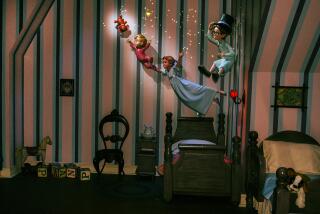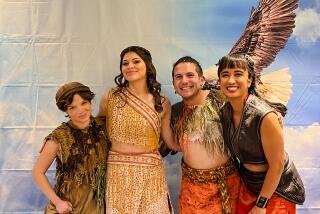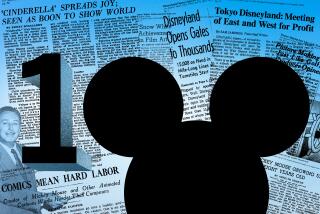MOVIE REVIEW : Disney’s ‘Peter Pan’: A Fantasy That Defies the Ravages of Age
- Share via
For children who grew up during the Baby Boom era, there were always two “Peter Pans”: the TV version with Mary Martin and the animated feature by Walt Disney. Each had its special charms, and the cartoon “Peter Pan” (in rerelease citywide) remains one of the most exciting and colorful films in the Disney canon.
Disney discarded the wistful nostalgia for the illusory innocence of childhood that pervaded Sir James Barrie’s original play and replaced it with brash Yankee energy. This Peter Pan is a cocky, all-American boy, more like Tom Sawyer than the smug British popinjay Barrie envisioned.
The Disney artists also changed or discarded much of the traditional stage business. For the first time, Peter was voiced by an actor (Bobby Driscoll), rather than portrayed by an actress. The Crocodile, who had always been an offstage sound effect, appeared on the screen. The artists eliminated Peter’s impassioned plea to the audience to clap their hands to prove they believe in fairies and save Tinker Bell’s life as a theatrical effect, rather than a cinematic one.
When the film was first released, critics complained about the portrayal of Tinker Bell as a human pixie rather than as a beam of light. This depiction is actually very close to Barrie’s descriptions of her as feminine, vain and slightly vulgar. Watch her monumental self-pity as she collapses into tears while Captain Hook bewails her abandonment by Peter.
The Disney crew made even greater changes in the Captain. Barrie’s elegant pirate who had “something of the grand seigneur “ about him was transformed into a volatile comic villain. Captain Hook’s battles with the ravenous Crocodile include some of the wildest, funniest scenes in any Disney cartoon. They represent a near-perfect marriage of slapstick animation and a deliciously overplayed vocal performance by the late Hans Conried.
Made in 1953 when the artists were still at the height of their powers, “Peter Pan” features some genuinely magic moments that expand the original play. No stage wiring could duplicate the freedom of movement Wendy, John and Michael experience when they discover they can fly. The sequence in which Peter turns the pirate ship to gold and sails it over the London skyline stands out as an example of a fantasy that can be realized only in animation.
The film carries its years very lightly, with one regrettable exception: its depiction of the Indians, including the “What Made the Red Man Red?” number. Although Disney treated them more respectfully than Barrie had, these characters are ‘50s movie Injuns , whose dialogue runs to “heap big” this and “do-um” that. The sequence is too long and too important to the story to cut. (Parts of it are also beautifully animated, especially Tiger Lily’s graceful dance.) For better or worse--probably worse--it remains a testament to Hollywood’s ethnic sensibilities during the ‘50s.
This complaint aside, “Peter Pan” is a wonderfully upbeat family entertainment that offers a welcome respite from the summer glut of fistfights, shoot-outs and car chases.
‘PETER PAN’
A Walt Disney Co. presentation, distributed by Buena Vista Pictures. Directors Hamilton Luske, Clyde Geronimi and Wilfred Jackson. Vocal cast Bobby Driscoll, Kathryn Beaumont, Hans Conried, Bill Thompson. Musical score Oliver Wallace.
Running time: 1 hour, 17 minutes.
MPAA-rated: G (general audiences).
More to Read
Only good movies
Get the Indie Focus newsletter, Mark Olsen's weekly guide to the world of cinema.
You may occasionally receive promotional content from the Los Angeles Times.










